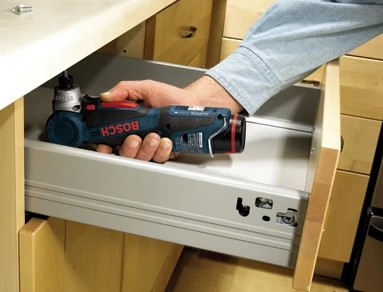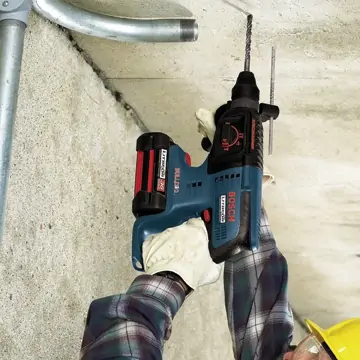Ever wondered how cell phones and laptops keep getting more compact and lighter in weight? Part of the answer comes from the breakthrough lithium-ion battery technology. These compact rechargeable batteries provide maximum power and longer runtime without adding the extra weight.
This is not the first time lithium-ion changed the way consumers look at electronics. And now, after years of research and millions of dollars in development by manufacturers, lithium-ion is starting to revolutionize a whole new category—cordless power tools.
From professional contractors to serious DIYers, lithium-ion battery technology is proving to be one of the biggest innovations in nearly 20 years. It could arguably be the biggest innovation the industry has experienced to date. As users and the industry as a whole try to grasp the magnitude of this technology, understanding the basic benefits and challenges of lithium-ion and cutting through the clutter will prove helpful to everyone, no matter the voltage size.
Maximum Power, More Runtime and No Weight Penalty
For years, professionals have relied on 18-volt NiCad batteries as the primary source for powering cordless tools. For cordless drill/drivers, rotary hammers, reciprocating saws, circular saws, jig saws, miter saws and more, 18-volt NiCad was the best balance between performance, weight and price. But just like any technology, users continue to demand more powerful, efficient and comfortable tools.
Capitalizing upon the inherent benefits of lithium-based chemistry, tools large and small, which were previously impossible with NiCad, are now a reality. Manufacturers can meet the demand and promise for more power and runtime without making the tool uncomfortably heavy, as was the case with the development of the 24-volt NiCad tool platform. And unique innovations for ultra-compact tools are also possible with mind-boggling power in an extremely small package.
For example, at the basic chemistry level, individual NiCad batteries hold 1.2 volts, while a single lithium-ion cell can hold and use up to 3.6 volts and still weigh less than a NiCad cell. Simply put, lithium-ion cells can either hold more power in the same size package or hold the same power in a smaller package. For example, a 36-volt lithium-ion battery offers twice the voltage capacity of an 18-volt NiCad battery for efficient high-amp draw tools, but weighs nearly the same. A 10.8-volt lithium-ion battery has comparable power to a NiCad at the same voltage, but is half the size of a 9.6-volt NiCad. Less weight combined with compact size and more power makes lithium-ion tools easier to handle and more productive, a major advantage for anyone using power tools.
When it comes to more runtime, the fact is that any increase in voltage for any battery chemistry will increase runtime. So, by increasing lithium-ion batteries to a higher voltage, such as 36-volts, users inherently benefit with a runtime increase. Just like NiCad, though, runtimes vary based on whether a particular application might draw more power than another. But, overall, the larger the voltage, the more runtime the user can expect. Moving forward, 36-volt batteries are the highest voltage the market will likely see for power tools.
Additional significant benefits of lithium-ion include a consistent level of performance from the beginning to the end of the discharge cycle and the ability to recharge the battery at any time without causing memory effect. With lithium-ion, users will not experience the dramatic dip in performance that NiCad batteries yield near complete discharge. The technology also eliminates memory effect, when a battery would no longer charge to full capacity after being partially charged and discharged a series of times. So, whether 20-percent or 99-percent charged, a user can recharge their battery to full anytime without causing cell damage.
Lithium-ion also provides users with an extended battery shelf life, which prevents batteries from drastically discharging when not in use over extended periods of time. Because contractors normally use their tools every day, do-it-yourselfers will likely see the greatest benefit. They will be able to store their batteries for months without experiencing a loss of charge. So the next time they reach for the tool, it is still ready for use.
Customizable and Task-specific Tools
Among the innovations made possible with the new technology, lithium-ion has enabled manufacturers to develop higher amp-draw tools, but also more compact and surprisingly powerful tools. At the lower end of the voltage spectrum, lithium-ion allows manufacturers to offer an impressive step up in power in the smallest package possible. At both ends, users now have the opportunity to select task-specific tools for particular applications, rather than only one tool for tasks large and small.
Most of today’s drill/drivers far exceed the level of torque users need for common everyday tasks like driving fasteners, drilling pilot holes and more. But without a truly ultra-compact and powerful solution, most are forced to carry around heavier overpowered tools. Now, with lithium-ion, ultra-compact drill/drivers, barely the size ofthe average hand, can accomplish the majority of the days work. They will even fit into a tool pouch for storage or can take on unique configurations to fit in normally hard-to-reach areas.
And for situations where a heavy-duty tool is required, tools such as 1-inch rotary hammers with chipping capability, band saws, reciprocating saws and more are now possible. Expanding tool offerings and maximum power in a cordless design will change the way pros and DIY’ers accomplish their work, wherever they are.
The Battery Cycle-life Challenge
While lithium-ion offers revolutionary advantages, many of the benefits discussed above are accessible to any manufacturer that applies the technology to their product. But unlike the constant low amp-draw experienced by cell phones and laptops, power tool manufacturers face a different challenge with more heavy-duty applications. The byproduct of frequent high amp-draw applications, such as sawing or drilling into dense materials, is heat which can damage battery cells. As a result, the battery’s cycle-life, the number of charges and discharges before a battery needs to be replaced, is drastically shortened. Only by engineering the battery and its cells to resist this condition are manufacturers able to bring a lithium-ion battery with an acceptable cycle-life to the professional market and not cost end users significant amounts of money to continually replace their batteries. Three design steps will protect and significantly extend a lithium-ion battery’s cycle-life, especially for heavy-duty applications: a higher voltage platform, electronic cell protection and specially engineered battery packs.
The first requires creating higher voltage batteries, such as 36-volts, to reduce the overall strain on the individual lithium-ion cells and enable them to last longer. A simple comparison can be made with car engines. A larger, more powerful engine does not need to work as hard to drive up a steep hill, because it can produce more than enough power to accomplish its task. But an engine half the size needs to work twice as hard, likely pushing itself to extremes and causing internal damage, to accomplish the same task. The same is true for batteries. A 36-volt battery simply does not need to work as hard as an 18-volt battery would in the same heavy-duty application. As a result, higher voltage lithium-ion batteries not only offer the extra power required to accomplish heavy-duty applications, but extend the life of the battery.

Many manufacturers incorporate a special electronics package within their lithium-ion tools and/or batteries designed not only to measure temperature but also monitor the number of times a trigger is pulled or a battery is used. Temperature measurement is important but it is not the full story. Some electronics packages also offer Electronic Cell Protection (ECP), the ability to manage the battery’s power output to eliminate potentially damaging conditions, such as overheating, and extend the battery’s cycle-life. Additionally, some manufacturers design their electronics within the actual battery pack instead of within the tool. Unfortunately, this can generate extra heat inside the battery and defeat the goal of minimizing heat in and around the battery cells. Both ECP and a smart design help to ensure the extended cycle-life of a lithium-ion battery.
Finally, manufacturers should engineer their batteries to stay cooler at all voltage levels, especially with more heavy-duty, high-powered tools. Battery housings should conduct heat away from the cells and battery core. Chargers should incorporate fans to feed air through battery vents to cool the individual cells before, during and after charging. And for higher voltage batteries, features such as cooling fins or other cooling designs incorporated into the shell will also help dissipate heat. By incorporating these types of design features, manufacturers can extend the cycle-life of a battery, reduce the number of replacements needed and make lithium-ion a truly valuable investment.
Editor’s Note: Edwin Bender is product manager for LITHEON cordless power tools, Bosch Power Tools and Accessories.





